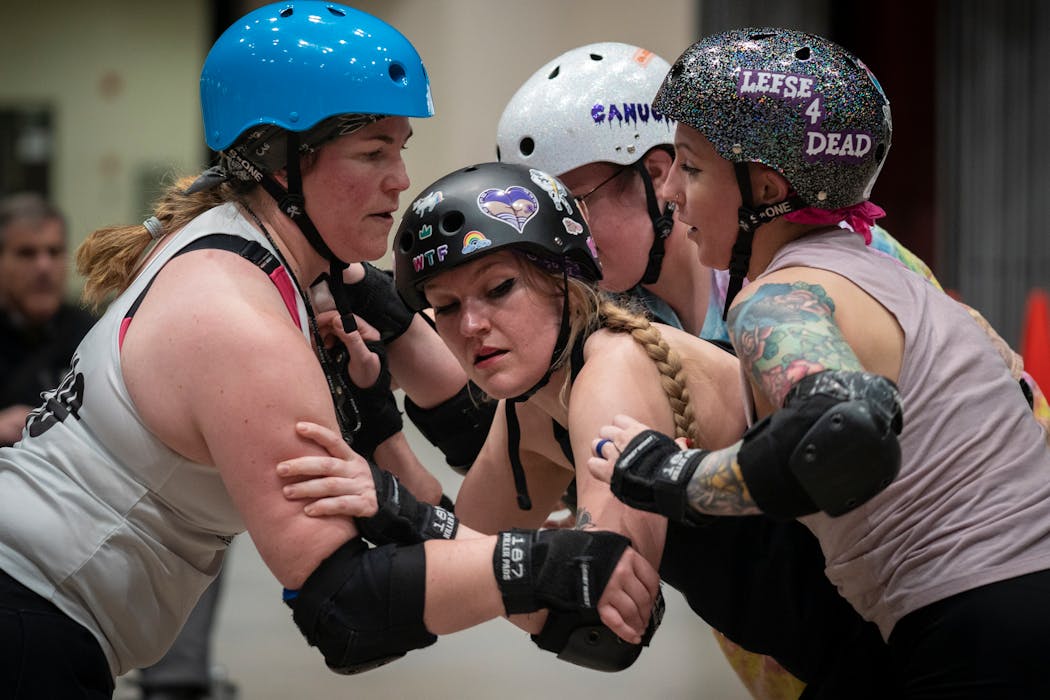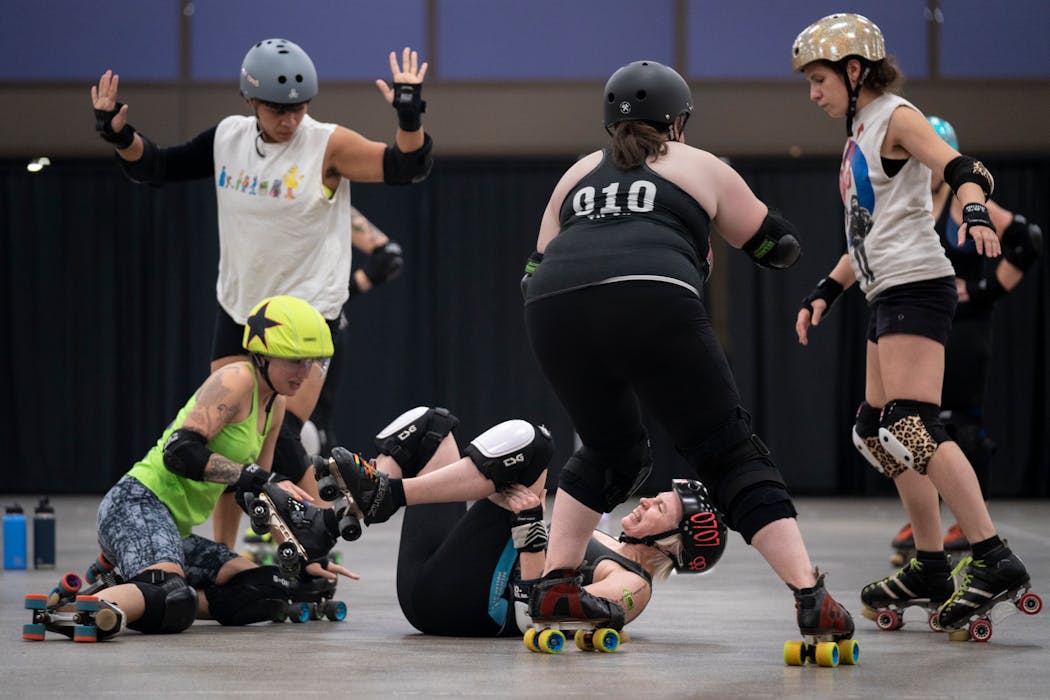Watching the smiling volunteers set up a small oval track on the floor of Roy Wilkins Auditorium with masking tape and pink markers, there was no sign of the dramatic transformation to come.
But minutes later, as dozens of roller derby players began their two-hour practice Thursday, the change from sleepy arena was jarring — as in bone-jarring, hip-checking, breathtaking, butt-thudding, fast-paced, addicting fun.
"Yeah," said Brianna O'Brien, minutes before transforming into her derby character Bri Zuss. "It's awesome. And we're pretty good."
For 20 years now, the members of Minnesota Roller Derby have made downtown St. Paul the scene for some of the best full-contact roller derby action around. Founded in 2004 as Minnesota RollerGirls, the group's all-star team has been a consistent Top 20 program in the world. And since 2005, Roy Wilkins has been their home.
According to its website, the team in 2019 changed its name to Minnesota Roller Derby to be more inclusive for the "women, non-binary and gender-expansive" folks drawn to the sport's brand of hard-hitting, fast-paced athleticism.
"We just define ourselves as basically anyone who feels they belong in a women's sport is welcome," said Casey Bissener, a team member who also serves as marketing director and board member.
At 7 p.m. Saturday, the group's four in-house teams — Bodies of Water, Roller Vortex, Maul Rats and Wednesday Warnings — will take to the track again.
Get ready, said Sarah Cohen — also known as MeshugEnough — for "bad-assery."
Where else can engineers, nurses, teachers and students transform into aggressive, fearless alter-egos who are encouraged to skate fast, hit hard and knock their friendly rivals off the track with a thud?
"You have to have tenacity to fall on concrete, to get hit by people, to get tackled by people," said Amanda Kettelhut of Prior Lake, aka Amanda Lorian. Kettelhut turned to roller derby eight years ago after starting in CrossFit and powerlifting in her 30s.
"You have to enjoy gritty practices. You have to enjoy struggling to learn new things," she said. "I just find a lot of satisfaction doing something at a high level with my friends."
The game, at its very basic level, pits two teams of five skaters each — four blockers and a jammer — on the track at a time. As in hockey, shifts alternate during a game's two 30-minute halves.
Points are scored when a team's jammer passes the other team's players. The blockers' job is twofold: Help their jammer score points while blocking the other team's jammer from passing them.
According to Max Becker, who coaches the all-star team, culled from the four in-house teams, that plays around the country, there are a number of strategies and tactics to accrue as many points as possible. But the heart of roller derby, he said, is toughness and tenacity.
"Grit and determination" make the best players, he said.
Between the club's in-house teams, its junior program and adult beginner training program, Bissener said 200 to 250 players, coaches and volunteers participate in Minnesota Roller Derby. Players pay dues of $20 a month to help pay the bills. Tickets priced at $16 and $18 also help; attendance at Roy Wilkins averages about 1,500 per event, she said.
Bissener, who came to roller derby after playing youth hockey for 10 years, said the sport can "feel like chaos" to beginners. "But players learn more of rules and strategy as they go."
Players wear helmets, kneepads, wrist guards and elbow pads. But injuries are common, Bissener said, and more a question of when than if. She's suffered a separated shoulder and a couple of concussions.
Julie MacGregor Farris, 50, came to roller derby after her daughter started participating in the junior program. The group's camaraderie appealed to mom as well, and she joined several months after her daughter started.
A cross-country skier and swimmer, MacGregor Farris had never played a contact sport before. Seven months ago, she broke her ankle in three places. But she was back on her skates a few weeks later.
"Everybody is so encouraging," she said of her teammates. "Everybody is falling and hurting themselves and training together. It's bringing out something in me that's incredibly positive."
O'Brien, who has been with the club since 2014, was drawn to roller derby after attending a game and loving the "vibe," she said.
"Literally, two weeks later, I went to tryouts," said jammer O'Brien, 40, considered one of the team's best players.
Greta Bolling, 16, never participated in sports before joining the club's youth program 2 1/2 years ago. Now, the art school student whose derby name is "Shreddy Mercury" said she can't imagine not playing into adulthood. She plans to go to college in New York and find a roller derby team to join there.
"This is my thing," she said, enthusiastically showing off a leg covered in blue and green bruises.
The sport, said Dana Johnson, has been transformative — for her and many of her teammates. A mechanical and industrial engineer, Johnson said she was "zero percent athletic before I joined roller derby" in 2015 after feeling alone and isolated.
"Here, I had a place to be physical, to exhibit that part of myself," said the now-powerfully built player who goes by the derby name "Val Kyrie." "Here, I found community. People who were really similar. I love it."

Federal funds to help restore Lake Superior sandbar

Brooks: Only you can prevent wildfires, Minnesota
Brooklyn Park police ask for help in search for man suspected of sexual assault at gunpoint





